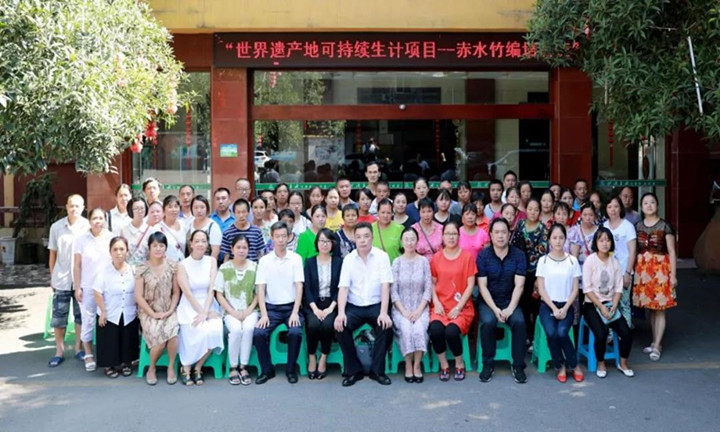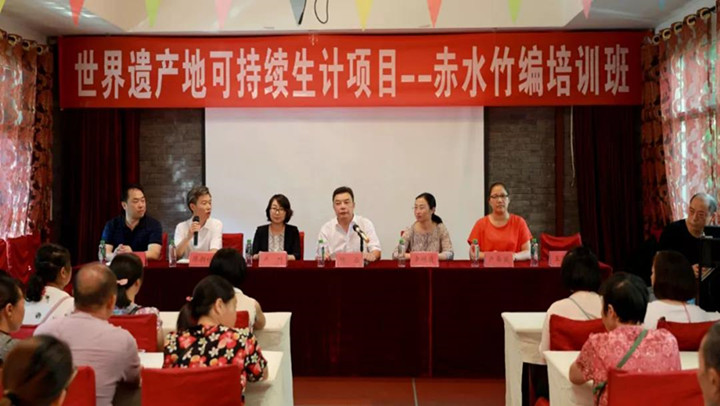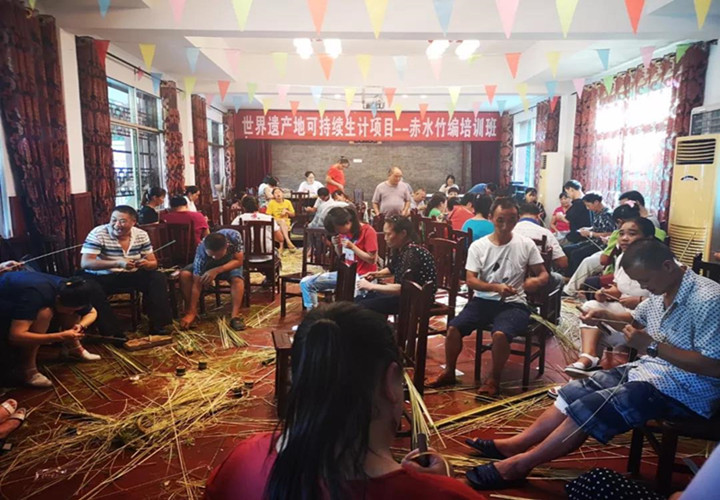遗产地保护与经济发展相冲突,怎么办?
贵州赤水的丹霞地貌吸引了众多游客,据赤水市旅游局数据,2017年赤水游客接待量达1600多万人次,旅游综合收入185.17亿元。

贵州赤水 / Chishui
中国丹霞世界遗产地的特征是壮观的红色悬崖以及一系列侵蚀地貌,包括雄伟的天然岩柱、岩塔、沟壑、峡谷和瀑布等。这样跌宕起伏的地貌,对保护当地的亚热带常绿阔叶林和动植物物起到了重要作用,其中包括约400种稀有或受威胁物种。
2010年,由贵州赤水等六处提名地组成的中国丹霞被列入联合国教科文组织《世界遗产名录》,这是对这六处提名地的突出普遍价值的肯定,同时也间接对当地生态的保护提出了更加严格的要求,例如禁止砍伐原始山林、限制游客数量等。

丹霞地貌 / Danxia landform
遗产地保护与经济发展的冲突并不少见,如何找到一条既不破坏遗产地生态又不妨碍当地经济发展的道路,联合国教科文组织一直在努力寻找答案,而这个答案一定是因地制宜的。那么,对于贵州赤水来说,答案又是什么呢?
除了著名的丹霞地貌,赤水还有一项有名的省级非物质文化遗产——赤水竹编。赤水竹编是一项技巧性较高的工艺绝活,最早可追溯到明末清初,它通过二十多道工序将1厘米宽的竹片分成20根竹丝,经过工艺师的精心编织,将竹丝编织成一幅幅书画艺术品和装饰品等。

赤水竹编 / CBW
如此有特色的地方工艺品,深受游客的青睐,但由于技术难度大、习艺时间长、制作周期长等原因,赤水竹编面临着后继乏人的困境。经考察,赤水拥有132.8万亩的丰富竹林资源,包括杂竹80万亩。竹编的主要原材料杂竹每两年一成材,其砍伐不会对当地生态及生物多样性产生负面影响。
因此,如果能够对赤水竹编加以推广,就能够在不破坏当地生态的基础上,既保护这项非物质文化遗产,又促进当地经济发展。同时,竹编作为一种在家就能操作的手工艺,能够吸引外出务工人员特别是妇女返乡就业,帮助缓解当地的留守儿童、留守老人问题。

赤水竹编培训班集体合照 / CBW Workshop group photo
赤水竹编培训班开班仪式 (左起:赤水农业广播学校校长柳卫东、赤水市风景名胜区管理局副局长廖朝林、联合国教科文组织驻华代表处项目官员卢叶、中国丹霞赤水世界自然遗产管理局副局长胡益、国际竹藤组织高级项目官员李艳霞、中国传统工艺美术大师卢华英) / CBW Workshop opening ceremony

今年,联合国教科文组织-中国青少年发展基金会梅赛德斯-奔驰星愿基金《中国世界遗产地保护和管理项目》启动了中国丹霞赤水世界自然遗产地2018年社区可持续生计活动,在当地开展赤水竹编培训班,提高竹编产品附加值,并且配合适当的营销策略,重塑赤水竹编产品市场格局,以期最终达到既保护当地生态,又提高当地居民收入的双赢目标。

赤水竹编培训班现场 / CBW Workshop
8月27至9月10日,54名自愿报名并通过筛选的农户参加了赤水竹编培训班,其中36人为女性,参培学员中还包括3位残障人士。在为期15天的培训中,赤水竹编传承人卢华英等为学员们讲解了破篾技术、灯笼制作、花盆编织等技艺。这次培训为赤水竹编培养了社区带头人,让更多当地居民了解并参与到这项传统技艺的传承和发扬中。本次活动由国际竹藤组织和赤水世界自然遗产管理局共同执行,并得到了赤水农业广播学校的支持,促进了多方合作伙伴关系的建立。
(本文部分图片由国际竹藤组织和赤水世界自然遗产管理局提供)
What should we do when the protection of heritage sites conflicts with economic development?
Many tourists visit Chishui to explore the Danxia landform there. According to Chishui Tourism Bureau, Guizhou province, in 2017, the number of tourists in Chishui reached more than 16 million, and the comprehensive tourism income was 18.517 billion yuan.
China Danxia World Heritage is characterized by spectacular red cliffs and a range of erosional landforms, including dramatic natural pillars, towers, ravines, valleys and waterfalls. These rugged landscapes have helped to conserve sub-tropical broad-leaved evergreen forests, and host many species of flora and fauna, about 400 of which are considered rare or threatened.
In 2010, China Danxia, composed of six nominated places include Chishui, was inscribed in the UNESCO World Heritage List. This affirmed the Outstanding Universal Value of these six nominated places. At the same time, however, it requires stricter protection of local ecology, such as prohibiting the cutting down of the original forests and limiting the number of tourists.
We often see conflicts between protecting World Heritage sites and developing local economy. How to find a win-win path to protect the ecology of the heritage site and to develop the local economy? UNESCO has been working hard to find an answer, and this answer must be tailored to local context. So, what is the solution for Chishui?
In addition to the famous Danxia landform, Chishui also has a famous provincial-level Intangible Cultural Heritage (ICH) – Chishui-based Bamboo Weaving (CBW). It is a highly skilled craftsmanship that can be traced back to the late Ming and early Qing dynasties. Through more than 20 procedures, craftsmen divide 1cm-wide bamboo into 20 bamboo filaments, then weave them into bamboo crafts.
Such unique local crafts are favored by tourists. However, due to technical difficulties, long learning time and long production cycle, CBW is facing the problem of lack of successors. Chishui has a rich bamboo forest resource of 88,533 hectare, including approximately 53,333 hectares of sundry bamboo, which is the main raw material of bamboo weaving. Sundry bamboo reaches maturity every two years. Cutting down sundry bamboo for CBW will not have a negative impact on local ecology and biodiversity.
Therefore, if we can promote CBW, we can protect this ICH and develop local economy without damaging the local ecology. At the same time, as a handicraft that can be done at home, CBW can encourage migrant workers, especially women, to return to hometown to work, which would help alleviate the situation of the left-behind children and left-behind elderly in the area.
This year, the UNESCO-China Youth Development Foundation-Mercedes-Benz Star Fund "Conservation and Management of World Heritage Sites in China" Project launched the 2018 Community Sustainable Livelihood Activity at Chishui China Danxia World Natural Heritage Site. The local activities include organizing CBW Training Workshop, increasing the added value of CBW products, generating marketing strategies for CBW, and reshaping the market pattern of CBW products, with a view to achieving a win-win goal of both protecting the local ecology and increasing the income of local residents.
From 27 August to 10 September, 54 farmers who voluntarily signed up and passed the screening participated in the CBW Training Workshop, 36 of which were women, and 3 persons with disabilities took part in the training. During the 15-day training, Lu Huaying, the successor of CBW, explained the techniques of bamboo splitting, bamboo-lantern making, and bamboo-flowerpot weaving. This workshop has trained community leaders for CBW, so that more local residents can understand and participate in the transmission of this traditional skill. This workshop jointly implemented by the International Network for Bamboo and Rattan (INBAR) and Chishui World Heritage Administration, and was supported by the Chishui Agricultural Broadcasting School, which promoted the establishment of multi-party partnerships.
来源:联合国教科文组织驻华代表处(已获授权转载)
责编:李贵清


 粤公网安备 44020402000152号
粤公网安备 44020402000152号

